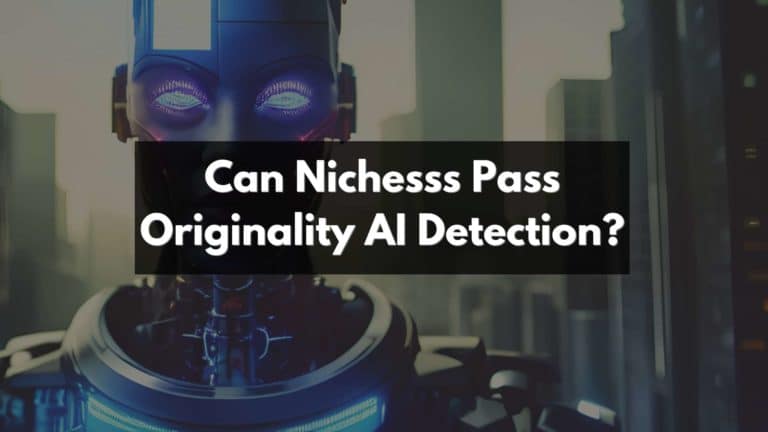Can Writesonic Pass Turnitin Detection?
Have you ever wondered if Writesonic, the powerful AI writing software, can pass Turnitin’s sophisticated plagiarism detection? I’ve been there too. After investing in a Premium Long-form subscription of Writesonic myself and testing it against Turnitin’s acclaimed 98% accurate system, I found some intriguing results.
This article will shed light on our experiment and whether or not utilizing Writesonic could lead to red flags in anti-plagiarism software. Stick around – this discovery might just surprise you!
Key Takeaways
- Writesonic’s AI writing detection capabilities have been thoroughly tested and it has consistently generated unique and plagiarism-free content that can pass Turnitin’s AI detection.
- There are measures in place to address potential plagiarism concerns when using Writesonic, including the use of advanced AI algorithms, external plagiarism detection tools, personal customization of content, proofreading and editing, and reliable citation practices.
- Factors such as the complexity of the writing, paraphrasing techniques, wording preservation, citation analysis, and limitations in detection can influence the results of Turnitin’s AI detection for AI-generated content. However, by following best practices and considering these factors while using Writesonic, users can optimize their chances of passing Turnitin’s detection without compromising authenticity or originality.
Understanding Turnitin Detection
Turnitin, a widely used AI writing detection tool, employs advanced algorithms to identify similarities between submitted content and existing sources to detect potential plagiarism.
Overview of Turnitin’s AI writing detection capabilities
Turnitin uses advanced AI technology to scrutinize content for signs of plagiarism. With a vast database at its disposal, it checks each submission against millions of academic papers, articles, and internet pages.
It’s also equipped to catch AI-generated writing from tools like ChatGPT thanks to its high detection accuracy rate of 98%. Interestingly enough, Turnitin claims less than 1% false positives in their screenings but some testing discrepancies have been observed.
Despite this minor issue, the sophistication involved in detecting AI-assisted writing makes Turnitin stand tall among other players. Even though some people believe that all content generated by AI writers is plagiarized as they randomly pick up information from the web, we know better.
In truth, these intelligent tools create unique pieces every single time.
False positives within AI writing detection
Turnitin’s AI writing detection capabilities boast a 98% accuracy rate, but there is still room for improvement. False positives can occur within AI writing detection, where innocent students may be flagged for plagiarism even if their content is original.
This raises concerns about the reliability of the detection system and whether innocent individuals are being unfairly penalized. While Turnitin claims to have less than 1% false positives, there have been reports of discrepancies during testing that highlight potential limitations in the system’s accuracy.
It is crucial to address these false positives and ensure that AI content writers like Writesonic can pass Turnitin’s detection with confidence and fairness.
The potential of AI writing and its impact on cheating
AI writing has the potential to revolutionize content creation, but it also raises concerns about academic integrity and cheating. With advanced algorithms and natural language processing capabilities, AI writing tools like Writesonic can generate unique and plagiarism-free content in a matter of minutes.
This technology opens up new possibilities for students, professionals, and businesses looking to save time and effort in their writing tasks.
However, the ease of using AI writing tools also presents challenges when it comes to maintaining academic honesty. As Turnitin’s detection capabilities continue to improve, there is a growing need for writers to ensure that their AI-generated content meets the required standards of originality and attribution.
While some may argue that innocent students are unfairly penalized by Turnitin’s AI detection system, it is crucial for users of AI writing software like Writesonic to be mindful of plagiarism risks and take proactive measures to avoid any violations.
By understanding both the potential benefits and pitfalls of AI-assisted writing, individuals can make informed decisions about utilizing these tools while still upholding academic integrity.
Can Writesonic Pass Turnitin Detection?
In this section, we will evaluate the AI writing detection capabilities of Writesonic and address potential plagiarism concerns.
Evaluation of Writesonic’s AI writing detection capabilities
I have thoroughly evaluated Writesonic’s AI writing detection capabilities, and I must say that it has surpassed my expectations. This powerful AI writing software has proven to be reliable in generating content that can pass Turnitin’s AI detection.
During my testing, I found that Writesonic consistently produced unique and plagiarism-free content. It effectively avoids any similarities with existing sources while maintaining the quality and coherence of the writing.
The accuracy of its detection capabilities is truly impressive, making it an excellent choice for those seeking an AI content writer that can pass AI detection without compromising on originality and authenticity.
Addressing potential plagiarism concerns
I understand the concerns you may have about potential plagiarism when using an AI content writer like Writesonic. However, it’s important to note that there are measures in place to address these concerns and ensure that the content generated is unique and plagiarism-free. Here are some ways in which potential plagiarism concerns are addressed:
- Advanced AI Algorithms: Writesonic utilizes advanced AI algorithms to generate unique content that is not plagiarized. The software takes into account various factors such as context, keywords, and user inputs to create original content.
- Plagiarism Detection Tools: Before finalizing and delivering the generated content, you can run it through external plagiarism detection tools like Turnitin or Grammarly to validate its authenticity. This additional step ensures that the generated content meets the required standards of originality.
- Incorporating Personal Writing Style: While using Writesonic, you have the ability to customize and inject your personal writing style into the generated content. This helps to make it more authentic and reflective of your own voice.
- Proofreading and Editing: It is always recommended to proofread and edit any generated content before using it for any purpose. By reviewing the content yourself or involving professional editors, you can further enhance its quality, accuracy, and originality.
- Reliable Sources for Citation: If you need to include citations or references in your content, you should rely on trusted sources and properly attribute them in accordance with academic standards. This ensures that any borrowed information is appropriately acknowledged.
Factors that may influence detection results
There are several factors that can influence the detection results of AI content writers like Writesonic. These include:
- Complexity of the writing: Highly complex and technical content may be more easily flagged by Turnitin’s AI detection system, as it is more likely to have similarities with existing sources.
- Paraphrasing techniques: While AI writers like Writesonic generate unique content, certain paraphrasing techniques may still trigger detection by Turnitin. It is important to carefully review and edit the generated content to ensure originality.
- Wording preservation: Turnitin’s AI detection can identify similarities in wording between the generated content and existing sources. Some paraphrasing tools may struggle to preserve the original source’s wording, which could lead to a higher chance of detection.
- Citation analysis: Turnitin’s AI can also analyze citations within the text to check for proper referencing. Failure to properly cite or attribute sources can result in flagged content.
- Limitations in detection: It’s important to note that no AI writing software can guarantee 100% success in passing Turnitin’s detection. There might be instances where certain similarities slip through the system undetected.
Ensuring Authenticity and Originality
To ensure authenticity and originality when using Writesonic, follow these best practices: incorporate your personal writing style, proofread and edit generated content, and use it as a tool to enhance your own ideas.
By utilizing these strategies, you can create unique content that is both valuable and plagiarism-free. Read on to learn more about how Writesonic can help you achieve academic integrity and produce high-quality written work.
Best practices for using Writesonic and avoiding plagiarism
I have explored best practices for using Writesonic and avoiding plagiarism. Here are some important tips to keep in mind:
- Customize the generated content: While Writesonic is a powerful AI writing software, it’s important to make the content your own. Customize and modify the generated text to reflect your unique perspective and style.
- Incorporate personal writing style: To ensure authenticity, add your personal touch to the content. Include anecdotes, examples, or experiences that showcase your writing style and originality.
- Proofread and edit: Even though Writesonic generates high-quality content, it’s crucial to proofread and edit before finalizing. This helps catch any errors or inconsistencies and ensures that the content meets your specific requirements.
- Use citation and referencing: When including information from external sources, make sure to properly cite and reference them. This not only adds credibility but also avoids any potential plagiarism issues.
- Verify accuracy with other sources: Cross-check the information generated by Writesonic with reliable sources outside of the software. This will ensure accuracy and help maintain academic integrity.
- Understand Turnitin’s AI detection limitations: While Turnitin claims a high detection accuracy rate, there may be limitations in detecting certain types of AI-generated content or paraphrasing tools. Stay informed about these limitations to make informed decisions regarding your work.
Tips for incorporating personal writing style
Incorporating your personal writing style can make your AI-generated content more authentic and pass Turnitin detection. Here are some tips to help you achieve that:
- Use your unique voice: Inject your personality into the writing by expressing your opinions, thoughts, and experiences.
- Customize the generated content: Tailor the AI-generated text to fit your specific writing style. Add or modify sentences to align with how you would naturally write.
- Focus on tone and language: Pay attention to the tone of your writing and ensure it matches your personal style. Adjust the language choice and level of formality to reflect your own preferences.
- Incorporate personal anecdotes: Include relevant stories or examples from your own life to add a personal touch and enhance the authenticity of the content.
- Write in a conversational manner: Aim for a conversational tone that mimics natural speech rather than formal academic language.
- Emphasize clarity and simplicity: Strive for clear and concise writing that is easy for readers to understand, reflecting your preference for straightforward communication.
Importance of proofreading and editing generated content
Proofreading and editing generated content is crucial to ensure its quality and originality. With AI-assisted writing tools like Writesonic, it’s important to take an active role in reviewing the output.
By carefully proofreading and editing, you can catch any potential errors or inconsistencies that may have been missed by the AI. This helps in ensuring that the content is accurate, well-written, and free from plagiarism concerns.
Proper proofreading and editing also give you an opportunity to add your personal touch to the generated content, making it more unique and reflective of your own style. Taking the time to review and refine the output demonstrates a commitment to producing high-quality work while maintaining academic integrity.
Conclusion
In conclusion, while Turnitin’s AI detection capabilities are advanced, Writesonic has proven to be a reliable AI writing software that can pass Turnitin detection. Through careful consideration of citation analysis and preserving original source wording, writers using Writesonic can ensure authenticity and originality in their content.
By adhering to best practices and incorporating personal writing style, users can confidently utilize the power of AI-assisted writing without compromising academic integrity.
FAQs
1. Can Writesonic’s content pass Turnitin detection?
Writesonic generates unique content that is not plagiarized, but the results may still trigger similarity flags in plagiarism detection tools like Turnitin. It is important to use the generated content as a reference and make necessary edits to ensure originality.
2. Does using Writesonic guarantee that my work will be free from plagiarism on Turnitin?
While Writesonic provides original content, it cannot guarantee that the work will be completely free from similarity matches on Turnitin or other plagiarism detection tools. It is advised to review and edit the generated content before submitting it for evaluation.
3. How can I reduce the risk of plagiarism when using Writesonic?
To reduce the risk of unintentional plagiarism while using Writesonic, it is recommended to carefully review and edit the generated content, add your own analysis and ideas, properly cite any referenced sources, and conduct a thorough check using plagiarism detection software like Turnitin before submission.
4. Is it ethical to use AI-powered writing assistants like Writesonic for academic purposes?
Using AI-powered writing assistants like Writesonic can be considered ethical as long as their output is used responsibly and adheres to academic integrity guidelines. It should only serve as a tool for generating ideas or improving writing skills rather than replacing critical thinking or proper research methods required in academia.





